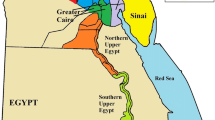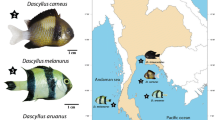Abstract
The genome of species from the buzzatii cluster (buzzatii complex, repleta group) is hosted by a number of satellite DNAs (satDNAs) showing contrasting structural characteristics, genomic organization and evolution, such as pBuM-alpha (~190 bp repeats), pBuM-alpha/beta (~370 bp repeats) and the DBC-150 (~150 bp repeats). In the present study, we aimed to investigate the evolution of these three satDNAs by looking for homologous sequences in the genome of the closest outgroup species: Drosophila martensis (buzzatii complex). After PCR, we isolated and sequenced 9 alpha, 8 alpha/beta and 11 DBC-150 sequences from this species. The results were compared to all pBuM and DBC-150 sequences available in literature. After D. martensis split from the buzzatii cluster some 6 Mya, the three satDNAs evolved differently in the genome of D. martensis by: (1) maintenance of a collection of major types of ancestral repeats in the genome (alpha); (2) fixation for a single major type of ancestral repeats (alpha/beta) or (3) fixation for new divergent species-specific repeat types (DBC-150). Curiously, D. seriema and D. martensis, although belonging to different and allopatric clusters, became independently fixed for the same major type of alpha/beta ancestral repeats, illustrating a rare case of parallelism in satDNA evolution. The contrasting pictures illustrate the diversity of evolutionary pathways a satDNA can follow, defining a “non-regular orbit” with outcomes difficult to predict.








Similar content being viewed by others
References
Abad JP, Agudo M, Molina I, Losada A, Ripoll P, Villasante A (2000) Pericentromeric regions containing 1.688 satellite DNA sequences show anti-kinetochore antibody staining in prometaphase chromosomes of Drosophila melanogaster. Mol Gen Genet 264(4):371–377
Adega F, Chaves R, Guedes-Pinto H, Heslop-Harrison JS (2006) Physical organization of the 1.709 satellite IV DNA family in Bovini and Tragelaphini tribes of the Bovidae: sequence and chromosomal evolution. Cytogenet Genome Res 114(2):140–146
Alkhimova OG, Mazurok NA, Potapova TA, Zakian SM, Heslop-Harrison JS, Vershinin AV (2004) Diverse patterns of the tandem repeat organization in rye chromosomes. Chromosoma 113(1):42–52
Bruvo B, Pons J, Ugarkovic D, Juan C, Petitpierre E, Plohl M (2003) Evolution of low-copy number and major satellite DNA sequences coexisting in two Pimelia species-groups (Coleoptera). Gene 312:85–94
Casals F, Cáceres M, Manfrin MH, González J, Ruiz A (2005) Molecular characterization and chromosomal distribution of Galileo, Kepler and Newton, three foldback transposable elements of the Drosophila buzzatii species complex. Genetics 169:2047–2059
Cesari M, Luchetti A, Passamonti M, Scali V, Mantovani B (2003) Polymerase chain reaction amplification of the Bag320 satellite family reveals the ancestral library and past gene conversion events in Bacillus rossius (Insecta, Phasmatodea). Gene 312:289–295
Charlesworth B, Sniegowski P, Stephan W (1994) The evolutionary dynamics of repetitive DNA in eukaryotes. Nature 371:215–220
Cohen S, Segal D (2009) Extrachromosomal circular DNA in eukaryotes: possible involvement in the plasticity of tandem repeats. Cytogenet Genome Res 124:327–338
Contento A, Heslop-Harrison JS, Schwarzacher T (2005) Diversity of a major repetitive DNA sequence in diploid and polyploid Triticeae. Cytogenet Genome Res 109:34–42
Dawe RK, Henikoff S (2006) Centromeres put epigenetics in the driver’s seat. Trends Biochem Sci 31:662–669
Dover GA (1982) Molecular drive: a cohesive mode of species evolution. Nature 199:111–117
Drosophila 12 Genomes Consortium (2007) Evolution of genes and genomes on the Drosophila phylogeny. Nature 450(8):203–218
Edgar RC (2004) MUSCLE: multiple sequence alignment with high accuracy and high throughput. Nucleic Acids Res 32(5):1792–1797
Ellingsen A, Slamovits CH, Rossi MS (2007) Sequence evolution of the major satellite DNA of the genus Ctenomys (Octodontidae, Rodentia). Gene 392:283–290
Excoffier L, Laval G, Schneider S (2005) Arlequin ver. 3.0: an integrated software package for population genetics data analysis. Evol Bioinform Online 1:47–50
Franco FF, Kuhn GCS, Sene FM, Manfrin MH (2006) Conservation of pBuM-2 satellite DNA sequences among geographically isolated Drosophila gouveai populations. Genetica 128:287–295
Franco FF, Silva-Bernardi ECC, Sene FM, Hasson ER, Manfrin MH (2010) Intra- and interspecific divergence in the nuclear sequences of the clock gene period in species of the Drosophila buzzatii cluster. J Zool Syst Evol Res. doi:10.1111/j.1439-0469.2010.00564.x
Guindon S, Gascuel O (2003) A simple, fast, and accurate algorithm to estimate large phylogenies by maximum likelihood. Syst Biol 52:696–704
Hall TA (1999) BioEdit: a user-friendly biological sequence alignment editor and analysis program for Windows 95/98/NT. Nucleic Acids Symp Ser 41:95–98
Henikoff S, Ahmad K, Malik HS (2001) The centromere paradox: stable inheritance with rapidly evolving DNA. Science 293:1098–1102
Heslop-Harrison JS, Brandes A, Schwarzacher T (2003) Tandemly repeated DNA sequences and centromeric chromosomal regions of Arabidopsis species. Chromosome Res 11:241–253
Kimura M (1980) A simple method for estimating evolutionary rate of base substitution through comparative studies of nucleotide sequences. J Mol Evol 16:111–120
Koukalova B, Moraes AP, Renny-Byfield S, Matyasek R, Leitch AR, Kovarik A (2009) Fall and rise of satellite repeats in allopolyploids of Nicotiana over c. 5 million years. New Phytol 186:148–160
Kuhn GCS, Sene FM (2005) Evolutionary turnover of two pBuM satellite DNA subfamilies in the Drosophila buzzatii cluster (repleta group): from alpha to alpha/beta arrays. Gene 349:77–85
Kuhn GCS, Bollgönn S, Sperlich D, Bachmann L (1999) Characterization of a species- specific satellite DNA of Drosophila buzzatii. J Zool Syst Evol Res 37:109–112
Kuhn GCS, Franco FF, Silva Jr WA, Rossi NMM, Sene FM (2003) On the pBuM189 satellite DNA variability among South American populations of Drosophila buzzatii. Hereditas 139:161–166
Kuhn GCS, Franco FF, Manfrin MH, Moreira-Filho O, Sene FM (2007) Low rates of homogenization of the DBC-150 satellite DNA family restricted to a single pair of microchromosomes in species from the Drosophila buzzatii cluster. Chromosome Res 15:457–469
Kuhn GCS, Sene FM, Moreira-Filho O, Schwarzacher T, Heslop-Harrison JS (2008) Sequence analysis, chromosomal distribution and long-range organization show that rapid turnover of new and old pBuM satellite DNA repeats leads to different patterns of variation in seven species of the Drosophila buzzatii cluster. Chromosome Res 16:307–324
Kuhn GCS, Teo CH, Schwarzacher T, Heslop-Harrison JS (2009) Evolutionary dynamics and sites of illegitimate recombination revealed in the interspersion and sequence junctions of two nonhomologous satellite DNAs in Drosophila species. Heredity 102:453–464
Lohe AR, Hilliker AJ, Roberts PA (1993) Mapping simple repeated DNA sequences in heterochromatin of Drosophila melanogaster. Genetics 134(4):1149–1174
Luchetti A, Cesari M, Carrara G, Cavicchi S, Passamonti M, Scali V, Mantovani B (2003) Unisexuality and molecular drive: Bag320 sequence diversity in Bacillus taxa (Insecta, Phasmatodea). J Mol Evol 56:587–589
Macas J, Navrátilová A, Koblízková A (2006) Sequence homogenization and chromosomal localization of VicTR-B satellites differ between closely related Vicia species. Chromosoma 115(6):437–447
Manfrin MH, Sene FM (2006) Cactophilic Drosophila in South America: a model for evolutionary studies. Genetica 126:1–19
Martins C, Baptista CS, Ienne S, Cerqueira GC, Bartholomeu DC, Zingales B (2008) Genomic organization and transcription analysis of the 195-bp satellite DNA in Trypanosoma cruzi. Mol Biochem Parasitol 160(1):60–64
Mravinac B, Plohl M, Ugarković D (2005) Preservation and high sequence conservation of satellite DNAs suggest functional constraints. J Mol Evol 61:542–550
Navajas-Pérez R, Rubio-Escudero C, Aznarte JL, Rejón, Garrido-Ramos MA (2007) SatDNA analyzer: a computing tool for satellite-DNA evolutionary analysis. Bioinformatics 23(6):767–768
Navajas-Pérez R, Quesada del Bosque ME, Garrido-Ramos MA (2009) Effect of location, organization, and repeat-copy number in satellite-DNA evolution. Mol Genet Genomics 282(4):395–406
Nei M (1987) Molecular evolutionary genetics. Columbia University Press, New York
Plohl M, Luchetti A, Mestrović N, Mantovani B (2008) Satellite DNAs between selfishness and functionality: structure, genomics and evolution of tandem repeats in centromeric (hetero)chromatin. Gene 409(1–2):72–82
Plohl M, Petrović V, Luchetti A, Ricci A, Satović E, Passamonti M, Mantovani B. (2009) Long-term conservation vs high sequence divergence: the case of an extraordinarily old satellite DNA in bivalve mollusks. Heredity. doi:10.1038/hdy.2009.141
Posada D (2008) jModelTest: phylogenetic model averaging. Mol Biol Evol 25(7):1253–1256
Powell J, DeSalle R (1995) Drosophila molecular phylogenies and their uses. Evol Biol 28:87–138
Richard GF, Kerrest A, Dujon B (2008) Comparative genomics and molecular dynamics of DNA repeats in eukaryotes. Microbiol Mol Biol Rev 72(4):686–727 (2008)
Robles F, de la Herrán R, Ludwig A, Ruiz Rejón C, Ruiz Rejón M, Garrido-Ramos MA (2004) Evolution of ancient satellite DNAs in sturgeon genomes. Gene 338:133–142
Rodríguez-Trelles F, Alarcón L, Fontdevila A (2000) Molecular evolution and phylogeny of the buzzatii complex (Drosophila repleta group): a maximum-likelihood approach. Mol Biol Evol 17(7):1112–1122
Ruiz A, Wasserman M (1993) Evolutionary cytogenetics of the Drosophila buzzatii species complex. Heredity 70:582–596
Saitou N, Nei M (1987) The neighbor-joining method: a new method for reconstructing phylogenetic trees. Mol Biol Evol 4:406–425
Shiels C, Coutelle C, Huxley C (1997) Contiguous arrays of satellites 1, 3, and beta form a 1.5-Mb domain on chromosome 22p. Genomics 44:35–44
Stephan W, Cho S (1994) Possible role of natural selection in the formation of tandem-repetitive noncoding DNA. Genetics 136:333–341
Strachan T, Webb D, Dover G (1985) Transition stages of molecular drive in multiple-copy DNA families in Drosophila. EMBO J 4:1701–1708
Tamura K, Dudley J, Nei M, Kumar S (2007) MEGA4: molecular evolutionary genetics analysis (MEGA) software version 4.0. Mol Biol Evol 24:1596–1599
Ugarković D (2009) Centromere-competent DNA: structure and evolution. Prog Mol Subcell Biol 48:53–76
Ugarkovic D, Plohl M (2002) Variation in satellite DNA profiles—causes and effects. EMBO J 21(22):5955–5959
Volpe TA, Kidner C, Hall IM, Teng G, Grewal SI, Martienssen RA (2002) Regulation of heterochromatic silencing and histone H3 lysine-9 methylation by RNAi. Science 297(5588):1833–1837
Walsh JB (1987) Persistence of tandem arrays: implications for satellite and simple-sequence DNAs. Genetics 115:553–567
Zimmer EA, Martin SL, Beverly SM, Kan YW, Wilson AC (1980) Rapid duplication and loss of genes coding for the alpha chains of hemoglobin. Proc Natl Acad Sci USA 77:2158–2162
Acknowledgments
We thank Fernando Faria de Franco (Federal University of São Carlos) and Maura H. Manfrin (University of São Paulo, Brazil) for kindly supporting us with DNA from Drosophila martensis and Jean Liggins (University of Leicester) for excellent technical assistance. G. Kuhn is supported at the Federal University of São Carlos with a personal postdoctoral fellowship from Fundação de Amparo à Pesquisa do Estado de São Paulo (FAPESP), Proc. 2009/08738-3.
Author information
Authors and Affiliations
Corresponding author
Additional information
Communicated by S. Hohmann.
Electronic supplementary material
Below is the link to the electronic supplementary material.
Supplemental Figure 1
Dot-plot graphic (70% stringency) showing an internal duplication in the DBC-180 repeats of D. martensis. The alignment of the internal repeats (corresponding to nucleotide positions 9 to 149) is shown below, with total lengths (bp) indicated in the end of each sequence (DOC 28 kb)
Rights and permissions
About this article
Cite this article
Kuhn, G.C.S., Schwarzacher, T. & Heslop-Harrison, J.S. The non-regular orbit: three satellite DNAs in Drosophila martensis (buzzatii complex, repleta group) followed three different evolutionary pathways. Mol Genet Genomics 284, 251–262 (2010). https://doi.org/10.1007/s00438-010-0564-1
Received:
Accepted:
Published:
Issue Date:
DOI: https://doi.org/10.1007/s00438-010-0564-1




